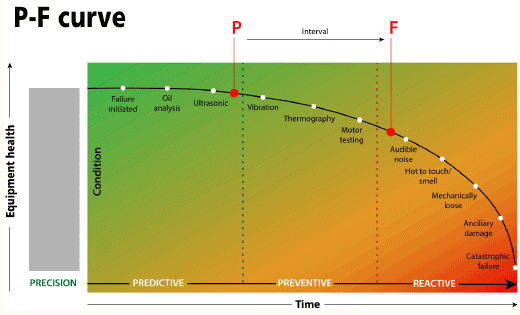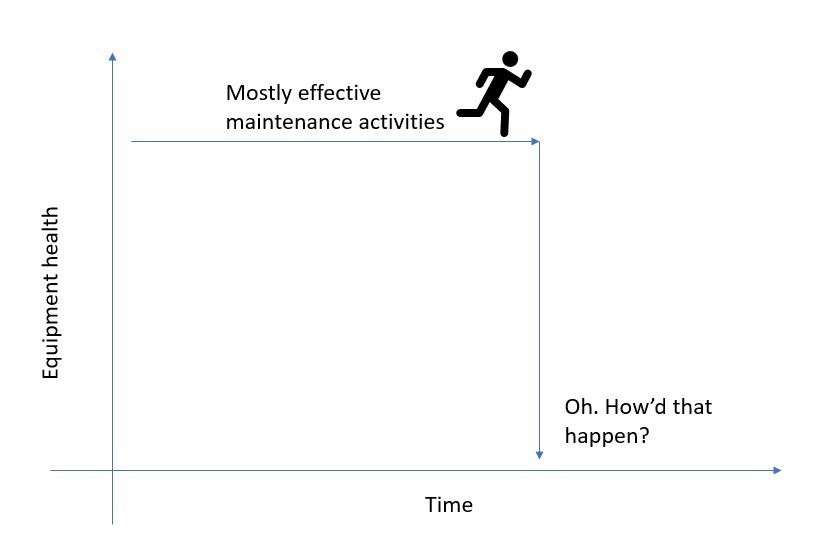
John Q. Todd
Sr. Business Consultant/Product Researcher
Total Resource Management (TRM), Inc.
Let me get right to it. I don’t think the P-F curve is really a curve anymore. Rather it is more like a cliff. We march right up to the edge with all our preventive maintenance activities and the equipment fails anyway. No gentle path downwards to follow, giving us lots of time to head off trouble. No, things simply go bad very quickly.
The idea is to avoid the cliff. Stay back a safe distance and enjoy the view vs. extending your toes over the edge for a thrill.
How do we use the P-F curve?
No need to re-write the vast number of books and articles about the P-F curve. We all know it quite well.

(Courtesy of isa.org)
As our equipment ages we do lots of stuff to keep it in service and productive. This may be a process we have performed for many, many years. Or we do the best we can up to a point then rip out the “old” and put in the new. Either way, there is a period where we care for the equipment to eek out as much as we can from it.
Yes, mechanical equipment does and will continue to “fail over time,” and condition-based maintenance tools do help us stay ahead of that “curve.”
However, the P-F curve lulls us into the idea that we have time before something bad happens. The equipment, despite our efforts, degrades at a rate (perhaps increasing) that we can plan for and, at some point there is no return… it fails. Gradual descent to the bottom. Oh well.
Is the P-F curve more like a cliff?
What if we looked at this more like a cliff to avoid falling over? Modern equipment is much more binary. It is either working or it is not. Slow degradation over time is still happening, but the likelihood of the equipment being replaced with an even more modern version is also becoming much more probable. What used to be a badge of honor to keep a 40-year-old pump in operation, has been replaced with completely different technology that you upgrade every 3 to 5 years.

As we implement and then rely upon automation, becoming more “digital,” more and more equipment is going to experience the cliff effect. There will be no (or much shorter) failure developing period. While the period of productive, failure-free life may be more consistent, with little to no degradation, failure may be more abrupt. Sensors and their related control boards come to mind. In the past they were nice to have, now they are critical pieces of our infrastructure.
Even now, most equipment failures are surprises. Go back in your mind over the last year of callouts and emergency repairs. How many did you see coming? I seriously doubt that you intuitively woke up at 2 AM and headed out to the plant, knowing that Pump A was about to fail. No, rather the 2 AM call was most likely a surprise.
But maybe you did have a sense (perhaps from actual data!) that Pump A was on its last legs. You could see the cliff in the distance and were making some efforts to avoid it. Kudos to you!
On the other hand, maybe, you don’t see the cliff coming. You are going about your maintenance activities, well within your budget and Bam! The pump grinds itself to death in a matter of seconds and the production line goes down for a week. Where did your gentle slope to the bottom go?
What is the real point here?
Expect that the unexpected is a certainty. Don’t be naive to think that you have time to “get to that pump inspection.” Just because the needle is in the green zone today, does not mean that it will stay that way. The flow rate from the pump could gradually drop off over time for a host of reasons. But, just as easily the pump could throw a chunk of the impeller and the whole thing will seize up… at 2 AM of course. Pull your preventive maintenance activities back to the left a bit, well away from the edge of the cliff.
TRM and IDCON have been working with companies to improve their maintenance processes and collect good data for decision-making for many years. Find out how we can help you avoid the cliff by contacting us.

0 Comments